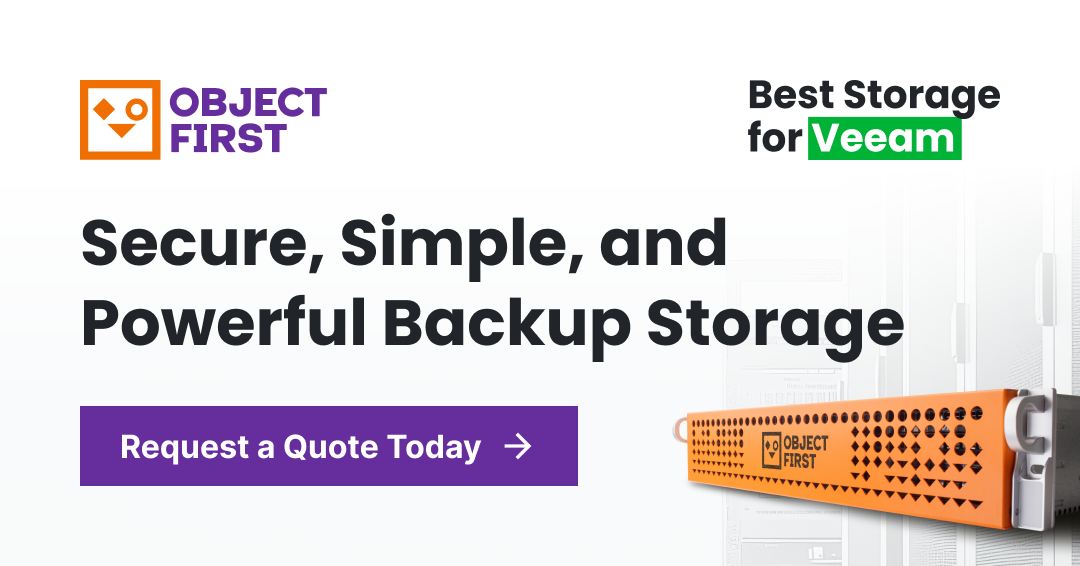Automated Backup: How It Works & Why You Need It
When you're the only person managing backup infrastructure, there's no room for error. You write scripts, run manual jobs, and hope nothing breaks while you're off the clock. Until one day, ransomware hits—encrypting everything, including the one backup you forgot to test.
Automated backup takes backup off your to-do list and turns it into a built-in layer of resilience. Learn how it works, why manual processes don't scale, and how to build a strategy that protects your data while saving you time.
What Is Automated Backup?
Automated backup is the process of using software to schedule and run regular data backups without manual effort. Once configured, it automatically backs up files, applications, or entire systems on a regular schedule—whether daily, hourly, or in real-time—reducing the risk of human error or missed backups.
Automated secure data backups keep your information protected consistently and quietly in the background by removing manual work from the equation. They're a reliable way to ensure your data is always safe and ready to recover without adding extra work to your day.
How Does an Automated Backup System Work?
An automated backup system follows a predefined sequence set by the backup administrator. It begins with scheduling—defining what data to back up and when. At the scheduled time, the system scans the data set, encrypts it (typically using AES-256), and transmits it over a secure connection like S3 over HTTPS to the designated backup target, whether that's local, cloud, or immutable on-prem storage.
Advanced systems go further by verifying backup integrity using checksums or hash validation, issuing instant alerts on failures, and allowing centralized policy management. Most automated backup systems rely on three core methods: full, incremental, and differential.
Full Backup
A full backup captures files, applications, and system configurations all in one go, every time it runs. It's the most complete way to back up your data and offers the fastest, most straightforward recovery, since there's only one backup file to work with.
Incremental Backup
Incremental backups only record what's changed since the last backup—whether that was a full or another incremental one. This makes them fast, lightweight, and far less demanding on storage and network resources.
Differential Backup
Differential backups capture all changes made since the last full backup. They grow larger with each cycle, but offer faster recovery than incremental ones, because you only need the full backup and the latest differential one.
9 Reasons to Use Automated Backup Solutions
Time Savings
They eliminate the need for manual intervention by running on fixed schedules, freeing up IT staff for higher-value tasks like optimization and incident response. They also reduce administrative overhead by standardizing workflows and ensuring consistency across environments.
Reduced Risk of Human Error
Manual processes are prone to mistakes like skipped steps, misconfigured paths, or overwritten files. Automation enforces policy-driven routines that eliminate variability, assuring backups are completed correctly every time, regardless of who’s on duty.
Consistent Backup Validation
Automated systems can run checksum or hash-based integrity checks after each backup, immediately flagging corruption or incomplete data sets. They allow teams to catch issues early, lowering the risk of discovering a failed backup during a critical ransomware recovery event.
Faster, More Predictable Recovery
By keeping backup data consistently up to date and properly indexed, automation streamlines the recovery process. IT teams can restore files, applications, or systems with minimal guesswork and no delays from outdated or misaligned snapshots.
Optimized RPO and RTO
Automated backups enable tighter Recovery Point Objectives (RPO) by running more frequently without additional effort. Combined with rapid data validation and streamlined recovery logic, they also help meet aggressive Recovery Time Objectives (RTO) during outages.
Stronger Disaster Recovery Readiness
In disaster recovery (DR) planning, automation ensures that critical systems are always covered without relying on human memory or manual workflows. Backup jobs can be prioritized, replicated offsite, and verified regularly to support near-instant failover scenarios.
Improved Auditability and Compliance
Automated backup systems generate consistent logs and reports, making compliance audits easier and more reliable. This level of traceability is indispensable for meeting standards like GDPR, HIPAA, and NIS2, where proving backup activity is as important as performing it.
Scalability Across Complex Environments
As data volumes grow, manual backup processes quickly become unsustainable. Automation allows organizations to scale protection policies across distributed systems, hybrid cloud setups, and large user bases—without sacrificing reliability or control.
Cost Efficiency
Automation reduces costs by eliminating manual tasks, cutting recovery time, and optimizing storage usage. Policy-driven scheduling and deduplication prevent backup sprawl, while fewer errors and faster restores lower both labor and downtime expenses.
Manual Backups vs. Automated Backups
In theory, both manual and automated backups aim to protect critical data.
But in reality, the differences are about control, consistency, and whether or not you can rely on your data backup strategy when disaster strikes.
| Feature | Manual Backups | Automated Backups |
|---|---|---|
| Execution Method | Initiated manually by IT staff or scripts; prone to variability in timing and scope. | Scheduled through software-defined policies and executed automatically without human intervention. |
| Risk of Human Error | High—missed backups, misconfigured jobs, and skipped steps are common, especially under pressure. | Minimal—backup logic and policies are enforced consistently, eliminating routine mistakes and oversight. |
| Operational Overhead | Requires dedicated attention from staff for setup, execution, and verification—especially in large environments. | Reduces workload by offloading repetitive tasks, allowing IT to focus on higher-impact areas like optimization and data security. |
| Backup Frequency | Inconsistent—depends on staff availability and manual execution discipline. | Highly consistent—backups run on fixed intervals (e.g., hourly, nightly) as defined in policy. |
| Data Integrity | Verification often skipped due to time constraints, increasing the chance of undetected corruption. | Built-in checksums and validation routines confirm data integrity after each backup run. |
| Recovery Speed (RTO) | Slower—recovery can be delayed due to outdated backups or incomplete data sets. | Faster—backups are current, complete, and indexed for quick restore with minimal manual input. |
| Scalability | Becomes inefficient and error-prone as environments grow or become more complex. | Scales effortlessly across hybrid, cloud, and multi-site environments without sacrificing reliability. |
| Disaster Recovery Readiness | Relies heavily on human memory and attention to detail—high risk of gaps in DR planning. | Ensures critical systems are always backed up and recoverable, forming the backbone of modern DR strategies. |
| Security Integration | Rarely includes native encryption, access control, or secure transmission protocols. | Integrates with IAM, MFA, encryption, and immutability to meet Zero Trust and ransomware protection standards. |
Automated Backup Software: What You Need to Know
Automated backup software drives modern data protection by executing scheduled tasks across systems and environments without manual effort. It manages when, where, and how data is captured—handling encryption, integrity checks, and secure transfers with minimal impact on production.
Enterprise backup solutions stand out through their ability to scale in hybrid environments, integrate with security protocols like MFA or IAM, and support advanced recovery features like granular restores or instant VM recovery.
Veeam Backup & Replication, for example, has become a go-to platform for enterprises managing complex workloads across virtual, physical, and cloud environments—thanks to its policy-driven automation and deep integration with modern infrastructure.
How to Choose the Best Automated Backup Software Solution
Define Your Recovery Objectives (RPO/RTO): Recovery Point Objective (RPO) dictates how much data loss is acceptable, while Recovery Time Objective (RTO) sets the maximum downtime. These metrics should shape your decisions on backup frequency, infrastructure design, and restore strategies.
Evaluate Platform Compatibility: The backup solution should natively support the systems and applications you protect—VMs, cloud services, SaaS platforms, databases, endpoints, and containers. Lack of coverage or vendor-specific limitations force you into fragile workarounds that increase complexity and risk.
Prioritize Security Features: End-to-end encryption, RBAC, MFA, and immutability aren’t add-ons—they’re table stakes. A strong security posture reduces your attack surface and aligns backup processes with Zero Trust principles.
Assess Scalability and Performance: As your environment grows, backup software must keep pace without running bottlenecks. Look for capabilities like global deduplication, multi-threaded processing, and policy-driven job execution.
Verify Recovery Capabilities: Backups are only useful if you can recover them quickly. The best platforms enable full system, app-level, or granular file recovery with minimal effort and support features like instant VM or mount-on-demand restores.
Check Automation and Policy Control: Backup logic should be defined by workload type, SLAs, or business unit, and should not be manually configured every time. Robust policy engines reduce risk and help enforce operational consistency.
Look for Reporting and Compliance Tools: Built-in logging, reporting, and compliance templates streamline audits and reduce manual effort. This is especially important in regulated industries or multi-tenant environments.
Ensure Flexible Storage Integration: Backup data needs to land on storage that matches your performance, cost, and compliance requirements. Whether you're using on-prem, cloud, or hybrid storage, the software should support it natively and allow for efficient tiering, retention control, and long-term scalability.
How Can I Back Up My Data Automatically?
Not every automated backup requires dedicated software. Some built-in options offer basic automation for individual users or small setups.
Here’s how they stack up:
- File History (Windows): Automatically saves hourly versions of personal files to a local or network drive. It’s easy to use but offers no protection against ransomware or physical device loss.
- Windows Backup (Windows 10/11): Schedules full or file-level backups to external or network storage. Useful for system recovery but lacks cloud support and advanced customization.
- OneDrive (Cloud Sync): Syncs files to the cloud in real-time for access across devices. Not a true backup—corruption or deletion locally is mirrored in the cloud.
- Time Machine (macOS): Creates hourly system snapshots for full or file-based recovery. Great for Mac users but limited in network support, encryption, and enterprise controls.
- Custom Scripts (e.g., rsync, robocopy, cron): Enables manual automation via scripting for advanced users. Powerful but fragile—no built-in error handling, logging, or recovery features.
These methods work in a pinch, but automated backup software is still the gold standard for scalable, secure, and resilient data protection.
Secure Backup Automation Starts with Immutable Storage
Choosing the right backup software is only half the equation. No matter how advanced your automation is, you compromise your last line of defense if your backups can be tampered with, deleted, or encrypted during an attack.
Ootbi (Out-of-the-Box Immutability) by Object First delivers secure, simple, and powerful on-premises backup storage for Veeam customers with no security expertise required.
Ootbi is built on the latest Zero Trust Data Resilience principles and delivers S3 native immutable object storage designed and optimized for unbeatable backup and recovery performance.
Download the white paper and learn why Ootbi is the Best Storage for Veeam.


